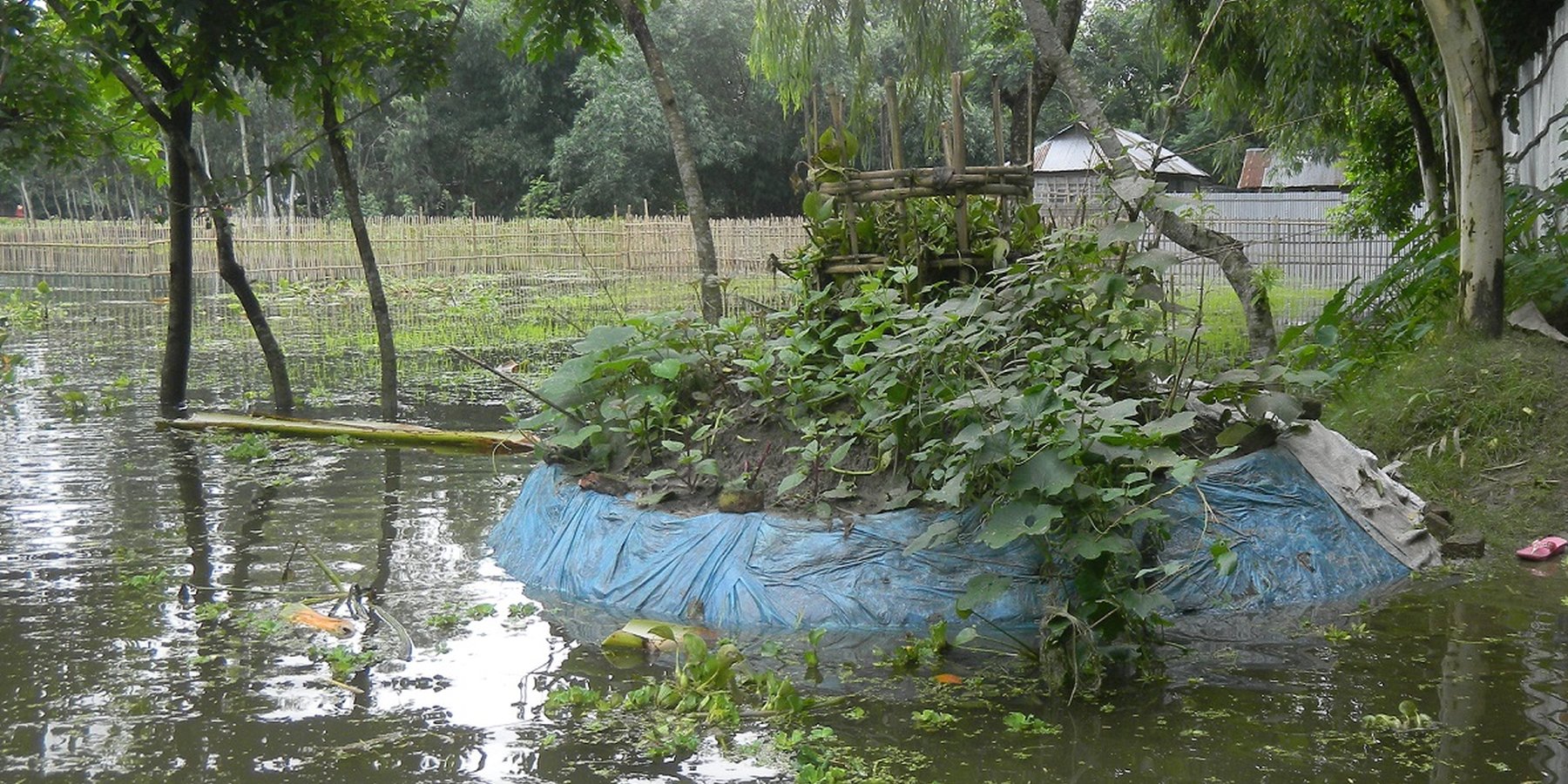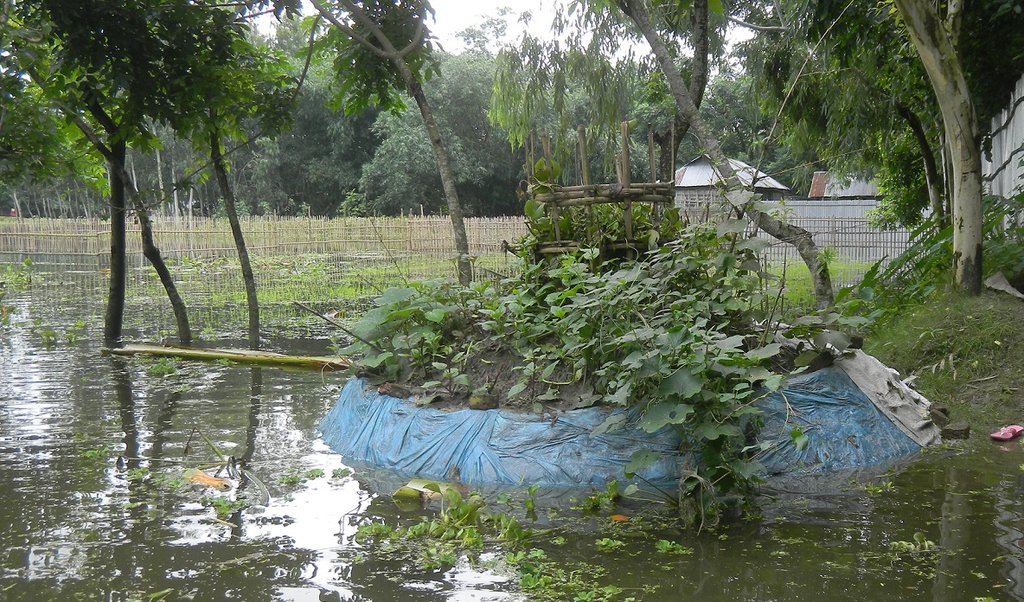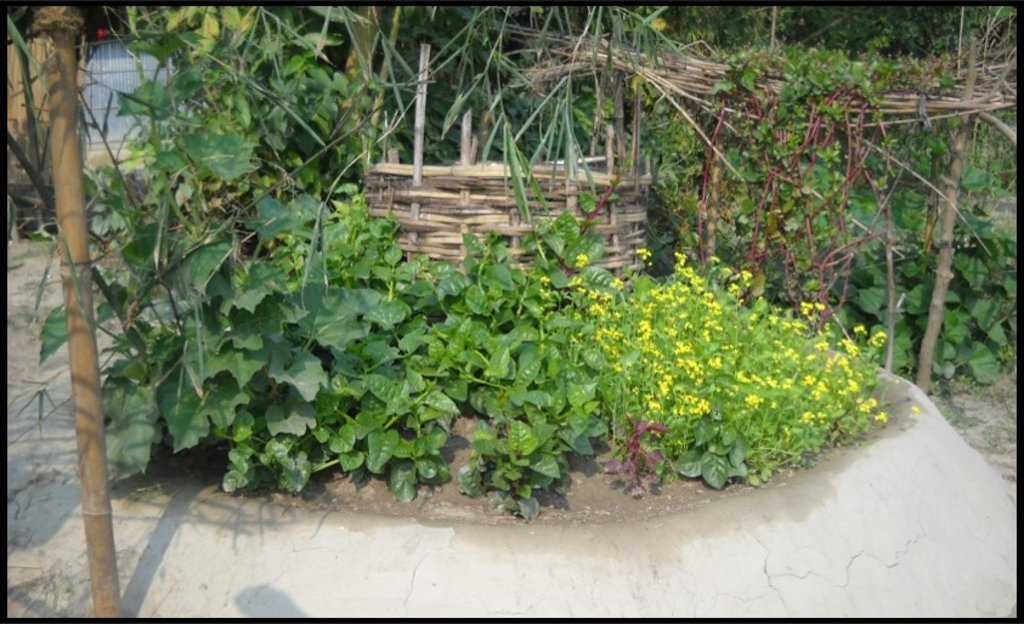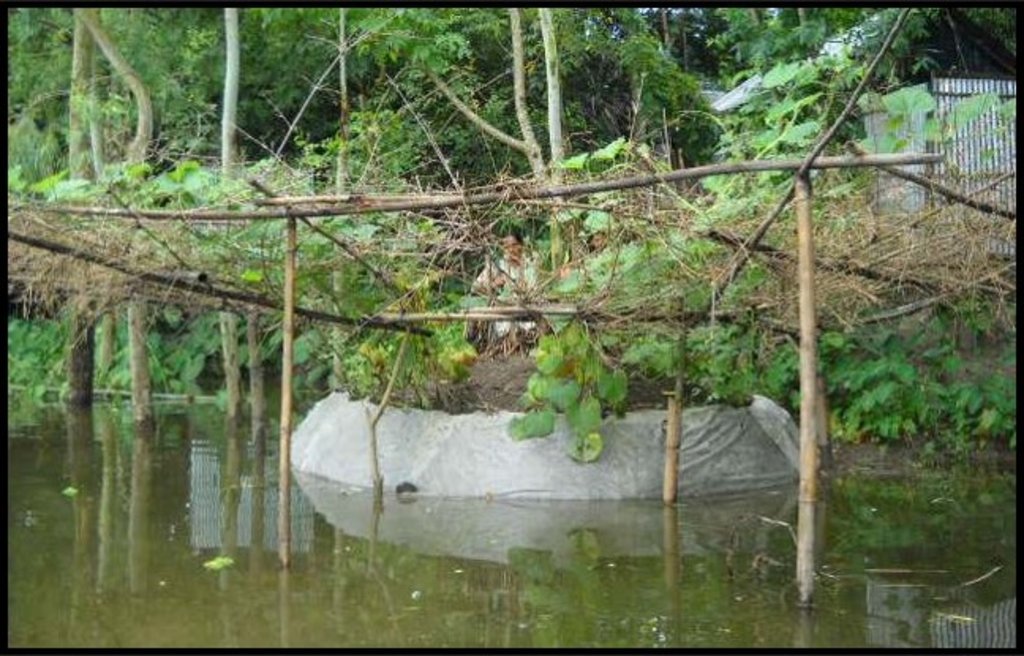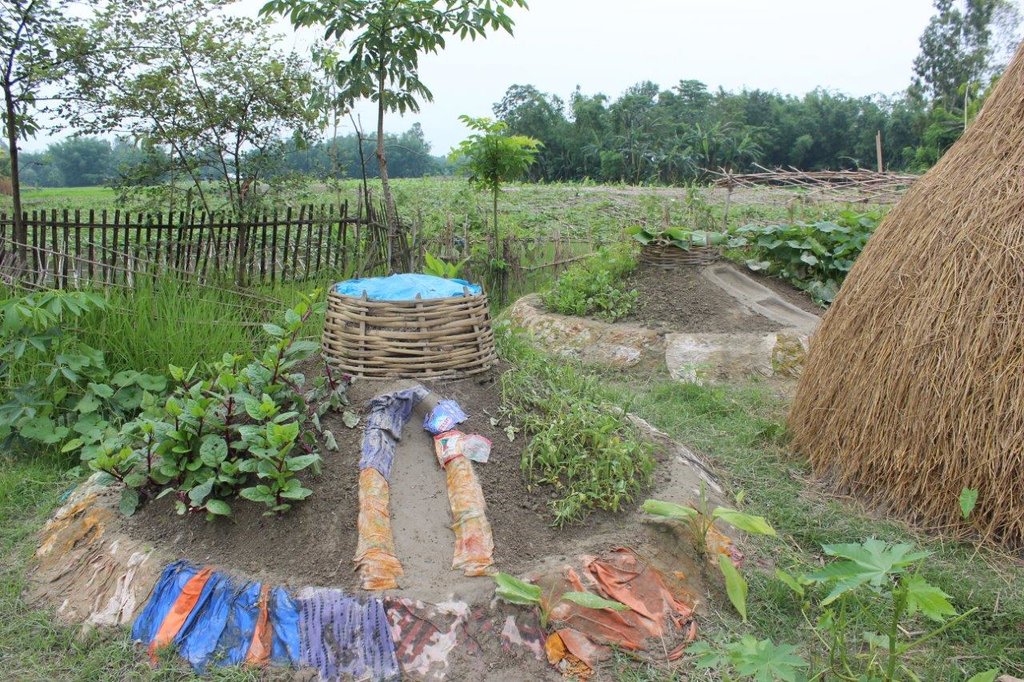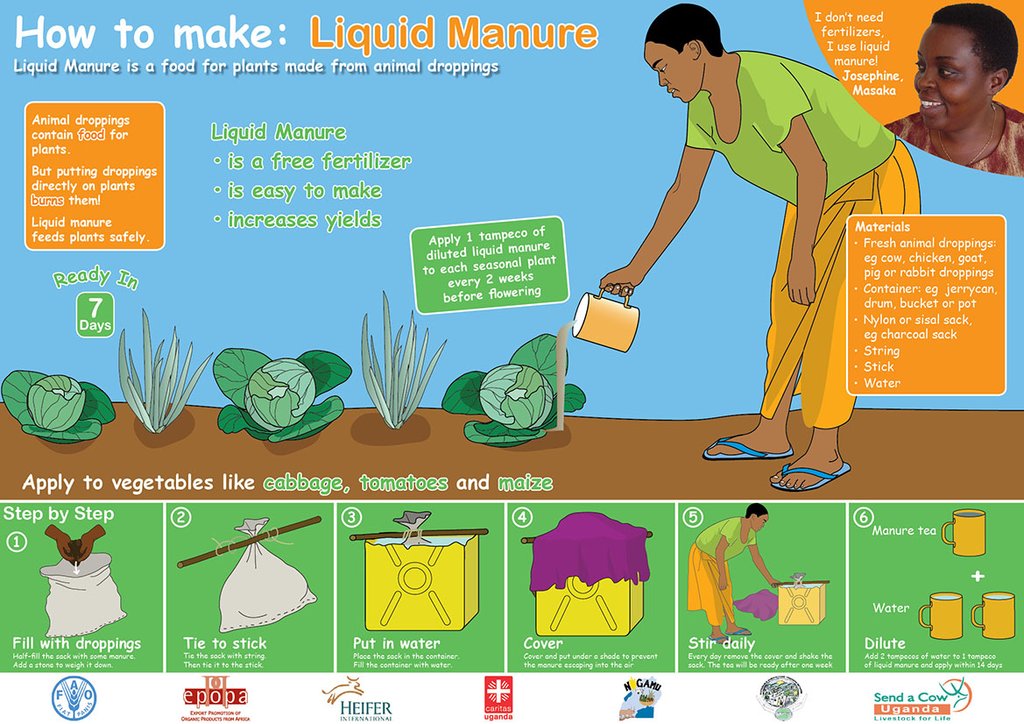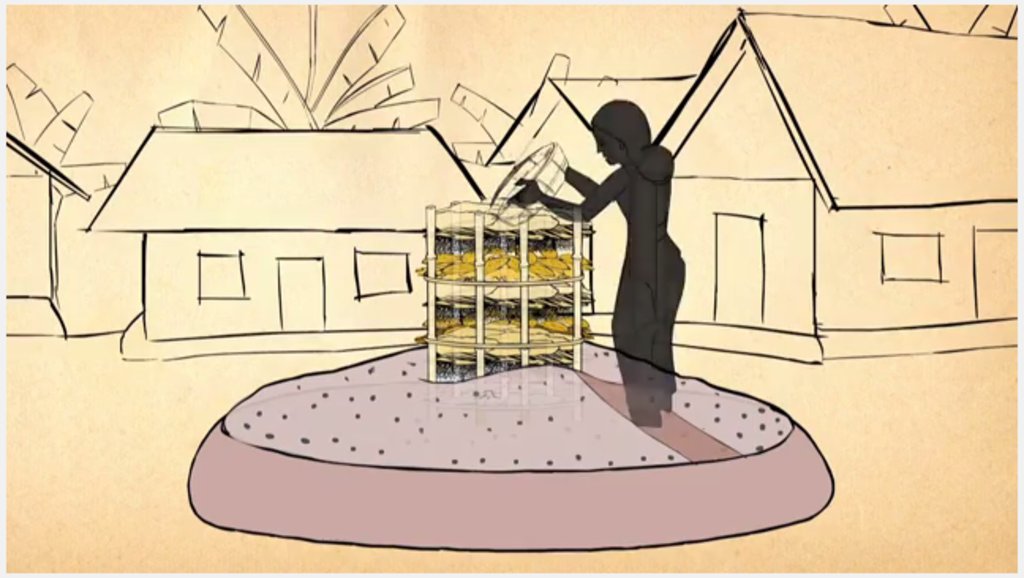Keyhole Garden [Бангладеш]
- Создание:
- Обновить:
- Составитель: John Brogan
- Редактор: Shahid Kamal
- Рецензенты: Alexandra Gavilano, Deborah Niggli, Alvin Chandra, Joana Eichenberger
PUSTI BAGAN ("Garden for nutrition")
technologies_779 - Бангладеш
Просмотреть разделы
Развернуть все Свернуть все1. Общая информация
1.2 Контактные данные специалистов и организаций, участвующих в описании и оценке Технологии
Специалист по УЗП:
Varadi Daniel
Greendots
Швейцария
Специалист по УЗП:
Taylor Sheila
Send a Cow UK & Greendots
WASH Advisor:
Название проекта, содействовавшего документированию/оценке Технологии (если применимо)
Book project: where people and their land are safer - A Compendium of Good Practices in Disaster Risk Reduction (DRR) (where people and their land are safer)Название организации (-ий), содействовавших документированию/оценке Технологии (если применимо)
Terre des Hommes (Terre des Hommes) - Швейцария1.3 Условия, регламентирующие использование данных, собранных ВОКАТ
Составитель и ответственный(-ые) специалист(-ы) согласны с условиями, регламентирующими использование собранных ВОКАТ данных:
Да
1.4 Декларация по устойчивости описываемой Технологии
Вызывает ли описанная здесь Технология проблемы деградации земель настолько, что ее нельзя назвать природосберегающей?
Нет
1.5 Ссылка на Анкету (ы) по Подходам УЗП (документируется с использованием ВОКАТ)
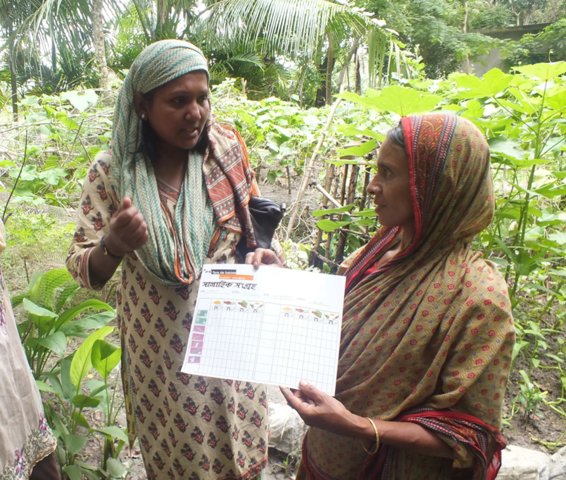
Peer to Peer Pass-on Approach with Women [Бангладеш]
Terre des hommes and Greendots introduced the Peer to Peer pass-on system to enable women's groups in Bangladesh to spread the Keyhole Garden technique within their communities with the aim of enabling year-round homestead vegetable production despite the risk of flooding and tidal surge.
- Составитель: John Brogan
2. Описание Технологии УЗП
2.1 Краткое описание Технологии
Определение Технологии:
The Keyhole Garden model of homestead vegetable cultivation enhances the resilience of families living in areas with climate-related hazards, such as flooding and drought. Keyhole gardens have been shown to increase vegetable production in all seasons, thereby improving household food autonomy and dietary diversity.
2.2 Подробное описание Технологии
Описание:
First initiated in Ugandan communities by Send a Cow UK, the keyhole garden technique is widespread in Africa. In 2011, Terre des hommes (Tdh) and Greendots piloted Keyhole Gardens for the first time in Asia, effectively adapting the design and methodology in Africa to the conditions of flood prone areas of Bangladesh, and eventually India. The garden is a good way to enhance dietary diversity, especially for poor/landless families.
Keyhole gardens consist of a raised circular garden made of clay, shaped like a horseshoe or keyhole, with a maximum diameter of approximately three meters. For flood prone areas in Bangladesh and India, the plinth height depends on the location and is typically the same as the house plinth to resist flooding. A compost basket is built at the center of the garden. Organic matter (kitchen cuttings) and residual water are added on a regular basis through the compost pit. In some countries, bricks or stones are used to make the plinth.
The keyhole garden is a typical Low External Input Sustainable Agriculture (LEISA) approach that includes integrated composting, water retention, use of local materials, natural pest and disease control techniques, natural soil fertility measures, and proximity to the kitchen for both harvesting and care of the garden. In regions with mild conditions of flooding, tidal surge and drought, the garden increases the duration of gardening period during the year thus reducing the risk of disaster. In the aftermath of cyclone Mahasen, keyhole gardens demonstrated DRR utility: although many were partially damaged, none had to be rebuilt entirely. Where plants did not survive the storm, users were able to sow seeds immediately. On the other hand, the traditional ground-level plots used for pit and heap gardening were completely flooded / waterlogged and unusable.
Benefits of the technology include: compact size, proximity to the household for convenient maintenance and harvesting, composting of kitchen cuttings in the basket; and an ergonomic structure (raised, accessible). The small size is also ideal to facilitate training on vegetable growing, soil fertility and pest & disease management to first-time gardeners and students in schools. Keyhole gardens are highly productive—in Lesotho a typical garden can satisfy vegetable needs for a family of eight persons (FAO, 2008). Combined, these factors are scalable as an appropriate technology for landless and marginal farmers. In Bangladesh, the gardens enabled families to produce vegetables even during the monsoon period. As the keyhole garden normally does not need to be rebuilt every year it is a more efficient technique in the long-term than traditional methods such as pit and heap.
Users say that their garden produce tends to be larger and tastier than conventional gardens or market produce; and many indicated that they were able to meet their own vegetable consumption needs and to sell surplus or gift vegetables. For some women it was difficult to access sufficient amounts of soil, which meant that they needed to walk long distances to build the plinth. (Fortunately many received support from other villagers.) Secondly, during the monsoon, while most of the land is flooded, the keyhole garden remains dry. Consequently, it may provide shelter to certain animals (e.g. rats) and attract higher number of pests. Regardless of these two limitations users agree that the benefits greatly
outweigh any observed limitations.
2.3 Фотографии, иллюстрирующие Технологию
2.4 Видеоматериалы, иллюстрирующие Технологию
Комментарий, краткое описание:
https://vimeo.com/44042261
The Keyhole garden was originally developed by African farmers to preserve their crops from the wind and the sand. Locally adapted in Bangladesh in Afzal’s vegetables garden with the help of Terre des hommes staff, the Keyhole garden can also protect the crops from the heavy monsoon rain and the salt water brought by flooding and storms. These literally destroy the crops. Widely adopted, it could help in preventing malnutrition by preserving the farmer's crops.
“Two days ago, my vegetable garden was wrecked by salt water and the monsoon rains”, says Afzal, who was the first person to test the new design proposed by Tdh and its technical partner Greendots. “The storm destroyed everything – except the keyhole garden, which is intact.”
Дата:
14/06/2012
Место:
Patharghata, Barguna District, Barisal Division, Bangladesh
Автор съемки:
Julien Lambert, Image of Dignity
2.5 Страна/ регион/ места, где применяется Технология, информация о которых собрана в данной Анкете
Страна:
Бангладеш
Административная единица (Район/Область):
Kurigram District / Rajshahi and Barguna District / Barisal
Более точная привязка места:
Kurigram municipality (Kurigram), Patharghata Union (Barguna)
Охарактеризуйте пространственное распространение Технологии :
- примененяется точечно/ на небольших участках
Пояснения:
Kurigram and Pataharghata, Bangladesh
Applied in homesteads.
Map
×2.6 Сколько лет применяется данная Технология
Год начала реализации:
2012
2.7 Внедрение Технологии
Укажите, как именно Технология УЗП была внедрена:
- как инновация (инициатива) землепользователей
- в качестве научного/ полевого эксперимента
- через проекты/ внешнее вмешательство
3. Классификация Технологии УЗП
3.1 Основные цели и задачи реализации Технологии
- повышение производства
- снижение риска стихийных бедствий
- адаптация к изменению климата / экстремальным погодным явлениям и их последствиям
- смягчение последствий изменения климата
3.2 Текущий(-ие) тип(-ы) землепользования на территории, где применяется Технология

Пахотные угодья и плантации
- Однолетние культуры
- Многолетние (недревесные) культуры
- Homestead Gardening
Ежегодный урожай - Уточните культуры:
- зерновые культуры - киноа или амарант
- бобовые - бобы
- овощи - листовые овощи (салаты, капуста, шпинат, другие)
- овощи - дыня, тыква, сквош или тыква
- овощи - другие
- овощи - корнеплоды (морковь, лук, свекла, другие)
- tomatoes, cauliflower, brocoli, watercress, eggplant, cucumber
Многолетние (недревесные) культуры - Уточните культуры:
- лекарственные, ароматические, пестицидные растения - многолетние
- chili
Число урожаев за год:
- 3
Поясните:
In Bangladesh the gardens produced in all seasons, with most challenges coming in the dry season due to soil salinity in some areas.
Применяются ли посевы в междурядьях?
Да
Применяется ли севооборот?
Да
Если да, укажите:
Winter/Summer seasons
Пояснения:
Winter Season: red amaranth, spinach, green chilli, tomato, eggplant, carrot, radish, onion, garlic, country bean, pumpkin, cabbage, cauliflower, broccoli.
Summer & Rainy Seasons: red amaranth, green amaranth, Indian spinach, Chinese watercress, green chili, okra, eggplant, yard long bean, bitter gourd, ash gourd, cucumber, pumpkin
3.3 Изменилось ли использование земель в связи с внедрением Технологии?

Водотоки, водные объекты, водно-болотные угодья
3.4 Водоснабжение
Обеспеченность водой участков, где реализуется Технология :
- сочетание богарных и орошаемых земель
3.5 Категория УЗП, к которой относится Технология
- Комплексное управление почвенным плодородием
- Комплексная борьба с сельскохозяйственными вредителями и болезнями (включая органическое сельское хозяйство)
- приусадебные участки
3.6 Мероприятия УЗП, выполняемые в рамках Технологии

Агрономические мероприятия
- A1: Растительный/ почвенный покров
- A2: Органическое вещество/ почвенное плодородие

инженерные мероприятия
- И11: Другие
3.7 Основные проблемы деградации земель, на решение которых направлена Технология

водная эрозия почв
- ВЭп: поверхностная эрозия/смыв верхних почвенных горизонтов
3.8 Предотвращение и снижение деградации земель, или восстановление нарушенных земель
Укажите цель Технологии по отношению к деградации земель :
- предотвращение деградации земель
- снижение деградации земель
Пояснения:
See details in section 2.2
4. Технические характеристики, мероприятия по практической реализации, вложения и стоимость
4.1 Технический рисунок, иллюстрирующий Технологию
Спецификация (пояснения к техническому рисунку):
Gardens should be built in close vicinity to the beneficiary’s house, because gardens that are easily accessible and clearly visible are visited more regularly and maintained better.
The design is highly adaptable to local conditions and availability of free construction materials. The radius of the garden is 150CM and the delineated radius of the circular compost basket (in the center of the garden) is 45cm. The diagrams show (1) the location is near to house as an entry point for maintaining the garden; (2) the plinth is built to the same level of the house and a step is included where the plinth is high; (3) mulching to conserve the moisture; (4) interplanting a diversity of vegetables for both good vegetable health and good family nutrition; (5) using interplanted natural repellent plants as pest control for vegetables; (6) covering the basket during times of high sun intensity or heavy rain; (7) using liquid manures and plant teas as top dressing fertilisers.
Establishing what is the best height for your plinth very much depends on the local climatological conditions. In Bangladesh, the plinth is built from subsurface clayey soil, typically 2-3 feet in height - dependent on the location and level of seasonal flooding. The house plinth is a good gauge for how high to build the garden plinth. If the plinth is built too high, the roots of the plant will not be able to access sufficient water; and if built too low the next flood during the monsoon season may destroy the garden. Depending on dryness or soil/groundwater salinity, daily maintenance usually includes irrigating the soil. The outer rim of the plinth is protected with mud (and plastic or cloth) or stones. On top of the plinth is a mixture of soil and compost/manure (ratio 2:1) sloped up to the basket at a 30 - 40 degree angle. The central compost basket is filled with layers of fresh and dried vegetable matter, manure and ash to ensure that the soil fertility of the garden.
Women devised a number of different solutions to protecting the wall of the plinth and garden: Plastic bags, a combination of rice sacks (around the plinth edge) and plastic entrance way because of wear and tear (rice sacks erode faster), palm matting and old cloth. Some women put extra manure in the plinth walls to protect against flooding.
Sam Rich (www.fourthway.co.uk) has produced other technical drawings in addition to "How to Make Liquid Manure" such as: "How to make a Natural Pesticide" and "How to Make Plant Tea". There is also a version of the "How to Make a Keyhole Garden" in English from the experience in Africa.
Автор:
Sam Rich: www.fourthway.co.uk
Дата:
13/05/2012
4.2 Общая информация по необходимым вложениям и стоимости
Уточните, как рассчитывались затраты и вложения:
- на технологическую единицу
Укажите единицу:
Keyhole Garden
Укажите денежные единицы, использованные для подсчета затрат:
- Доллары США
Укажите среднюю дневную заработную плату наемных работников:
U.S.$2.50
4.3 Мероприятия, необходимые для начала реализации
| Деятельность | Время (сессия) | |
|---|---|---|
| 1. | Clear land; mark out basket and external boundary using rope and stick pivoted from the centre) | Anytime |
| 2. | Build plinth (highest monsoon flood level+30cm); | Anytime |
| 3. | Construct basket at the centre from local materials. Fill basket with composting materials; | Anytime |
| 4. | Bring soil and heap it around the central basket. Any available animal dung can also be added into the soil mix for greater initial productivity. | Anytime |
| 5. | Plant vegetable seeds around the garden - a mix for good family nutrition and to stop the spread of pests and diseases; | According to the seasonal varieties |
| 6. | Mulch between plants to protect the soil. | Anytime |
| 7. | Protect the walls with rice sacks or other waterproof protection if neccessary. | Anytime |
4.4 Вложения и затраты, необходимые для начала реализации
| Опишите затраты | Единица | Количество | Затраты на единицу | Общая стоимость на единицу | % затрат, оплаченных землепользователями | |
|---|---|---|---|---|---|---|
| Оплата труда | Building the garden | person-days | 3,0 | 2,5 | 7,5 | 100,0 |
| Строительные материалы | clay | 20,0 | ||||
| Общая стоимость запуска Технологии | 7,5 | |||||
| Общие затраты на создание Технологии в долларах США | 7,5 | |||||
Пояснения:
Firstly, building the garden requires an initial investment in terms of labour and (locally available) inputs, such as soil and wood and clayey soil for the plinth (stones and bricks are frequently used for the plinth in Africa). These inputs are available on the homestead or in the community and generally free of cost. In rare cases families paid to have soil carted to their homestead, thus increasing the initial structural costs.
4.5 Поддержание/ текущее обслуживание
| Деятельность | Сроки/ повторяемость проведения | |
|---|---|---|
| 1. | Weeding, harvesting, watering | Daily |
| 2. | Structural maintenance on the garden | Annual |
4.6 Стоимость поддержания/ текущего обслуживания ( в год)
| Опишите затраты | Единица | Количество | Затраты на единицу | Общая стоимость на единицу | % затрат, оплаченных землепользователями | |
|---|---|---|---|---|---|---|
| Оплата труда | Maintenance | person-days | 11,0 | 2,5 | 27,5 | 100,0 |
| Оплата труда | Structural maintenance on the garden | person-days | 1,0 | 2,5 | 2,5 | 100,0 |
| Строительные материалы | Earth Clay -depends on height: ex .4m plinth) | cubic meter | 11,0 | |||
| Строительные материалы | Manure (quantity depends on design) | cubic meter | 2,0 | |||
| Строительные материалы | Basket (sticks/bamboo with thin sticks to weave the basket | Sticks | 15,0 | |||
| Строительные материалы | Protective material, rice bags/stones/plastic | Square meter | 18,0 | |||
| Общая стоимость поддержания Технологии | 30,0 | |||||
| Общие затраты на поддержание Технологии в долларах США | 30,0 | |||||
Пояснения:
In Bangladesh, women referred to the time spent working on the keyhole garden as “leisure time” and that they do this work after they have completed their domestic chores. Women estimated 45 minutes daily of such activity to maintain the garden. Calling it "leisure time" is misleading, but it suggests that most women generally enjoy working in the garden and do not regard it as heavy labour. The daily wage of an agricultural labourer differs per region. In Tdh's project area, wages are relatively low, especially for women. While male labourers may earn 200 BDT ($2.50) per day, women usually earn only 90 to 150 BDT. For the calculation, we applied the principle of equal pay for equal work, taking 200BDT per day.
4.7 Наиболее значимые факторы, влияющие на стоимость затрат
Опишите наиболее значимые факторы, влияющие на стоимость затрат:
Over the last few years, people in disaster-affecteed areas of Bangladesh have become familiar to receiving during humanitarian distributions; and expect “hand-outs” if they were to participate in a development project. The Keyhole garden project, however, follows the LEISA approach and does not rely on giving free inputs to the participants. (In a few cases where the local population was lacking seeds and experience in seed production, women's groups were given seeds and training.) A lack of reliance on external inputs or subsidies contributes to the sustainability of the project. The inputs (clay, manure, sticks, rocks, etc.) are locally available and usually do not require additional expenses. This may not be the case in all contexts.
5. Природные и социально-экономические условия
5.1 Климат
Среднегодовое количество осадков
- < 250 мм
- 251-500 мм
- 501-750 мм
- 751-1000 мм
- 1001-1500 мм
- 1501-2000 мм
- 2001-3000 мм
- 3001-4000 мм
- > 4000 мм
Укажите среднегодовое количество осадков (если известно), мм:
2666,00
Пояснения/ комментарии по осадкам:
Applied in areas with monsoon and drought like conditions in the project areas in Bangladesh.
Укажите название соответствующей метеостанции:
http://data.worldbank.org/indicator/AG.LND.PRCP.MM
Агроклиматическая зона
- влажная
- Умеренно-влажная
- полузасушливая
The technology is adapted to semi-arid areas/countries in Africa like Uganda and Tanzania.
5.2 Рельеф
Склоны (преобладающие):
- пологие (0-2%)
- покатые (3-5%)
- покато-крутые (6-10%)
- крутые (11-15%)
- очень крутые (16-30%)
- чрезвычайно крутые (31-60%)
- обрывистые (>60%)
Формы рельефа:
- плато/ равнины
- гребни хребтов/холмов
- склоны гор
- склоны холмов
- подножья
- днища долин
Зона высотной поясности:
- 0-100 м над уровнем моря
- 101-500 м н.у.м.
- 501-1000 м н.у.м.
- 1001-1500 м н.у.м.
- 1501-2000 м н.у.м.
- 2001-2500 м н.у.м.
- 2501-3000 м н.у.м.
- 3001-4000 м н.у.м.
- > 4 тыс. м н.у.м.
Укажите, приурочено ли применение Технологии к специфическим условиям:
- не имеет значения
5.3 Почвы
Средняя мощность почв:
- поверхностные (0-20 см)
- неглубокие (21-50 см)
- умеренно глубокие (51-80 см)
- глубокие (81-120 см)
- очень глубокие (> 120 см)
Гранулометрический состав (верхнего горизонта):
- тонкодисперсный/ тяжёлый (глинистый)
Гранулометрический состав (на глубине более 20 см):
- тонкодисперсный/ тяжёлый (глинистый)
Содержание органического вещества в верхнем горизонте:
- среднее (1-3%)
5.4 Доступность и качество воды
Уровень грунтовых вод:
< 5 м
Доступность поверхностных вод:
избыток
Качество воды (без обработки):
питьевая вода плохого качества (необходима обработка)
Является ли солёность воды проблемой?
Да
Поясните:
In project sites along the Bay of Bengal
Происходят ли периодические затопления территории?
Да
Регулярность:
часто
5.5 Биоразнообразие
Видовое разнообразие:
- низкое
Разнообразие местообитаний:
- средняя
5.6 Характеристика землепользователей, применяющих Технологию
Осёдлый или кочевой:
- Осёдлый
Рыночная ориентация производства:
- натуральное хозяйство (самообеспечение)
- смешанный (натуральный / коммерческий)
Доходы из других источников:
- < 10% всех доходов
- 10-50% всех доходов
Относительный уровень достатка:
- очень плохой
- плохой
Индивидуальное или коллективное хозяйство:
- частное/ домовладение
Уровень механизации:
- ручной труд
- тягловая сила
Пол:
- женщины
- мужчины
Возраст землепользователей:
- средний возраст
Укажите другие важные характеристики землепользователей:
Using a methodology called the problem tree analysis it is understood that the people living in the two working areas regularly experience health-related problems, economic challenges, and agricultural difficulties.
5.7 Средняя площадь земель, используемых землепользователями с применением Технологии
- < 0,5 га
- 0,5-1 га
- 1-2 га
- 2-5 га
- 5-15 га
- 15-50 га
- 50-100 га
- 100-500 га
- 500-1000 га
- 1000-10000 га
- > 10000 га
Считается ли это мелким, средним или крупным хозяйством (по местным масштабам)?
- мелкое
Пояснения:
The majority of the project beneficiaries are "landless" having access to small homestead areas and without cropland. Most households have access to small (< 16 decimal) or very small (< 6 decimal) homestead areas.
5.8 Собственность на землю, права на земле- и водопользование
Землевладелец:
- индивидуальная, не оформленная в собственность
Право землепользования:
- индивидуальное
Право водопользования:
- неограниченное (неконтролируемое)
5.9 Доступ к базовым услугам и инфраструктуре
медицинское обслуживание:
- плохой
- средний
- хорошая
образование:
- плохой
- средний
- хорошая
технические консультации:
- плохой
- средний
- хорошая
занятость (вне хозяйства):
- плохой
- средний
- хорошая
рынки:
- плохой
- средний
- хорошая
электроснабжение:
- плохой
- средний
- хорошая
транспорт и дорожная сеть:
- плохой
- средний
- хорошая
водоснабжение и канализация:
- плохой
- средний
- хорошая
финансовые услуги:
- плохой
- средний
- хорошая
6. Воздействия и заключительные положения
6.1 Влияние Технологии УЗП в пределах территории ее применения
Социально-экономическое воздействие
Продуктивность
производство сельскозяйственных культур
Количество до применения УЗП :
<5% of pilot families growing vegetables in all 3 seasons
Количество после применения УЗП:
50% of the pilot families able to grow vegetables in 3 seasons
Комментарий/ пояснения:
Before the project started, the majority of the participants were not able to produce vegetables year round. Especially during the monsoon months, people were dependent on produce available at the local market. The baseline survey indicated that in both regions more than 50% of the households would cultivate vegetables for a maximum of 3 months per year and in Kurigram 30% of the participants were not able to grow vegetables at all.
This situation has changed significantly after the introduction of the keyhole gardens. At least 50% of the households were able to produce vegetables during each season. Where in the past almost no one was able to cultivate during the monsoon period, now on average 63% of the households in Kurigram and 73% of the households in Patharghata were growing vegetables in the wet season.
The summer figures are actually lower than the monsoon figures. Seeds did not germinate well, because participants were not fully prepared to deal with the dry and saline conditions during this season. Learning from this experience, and with adequate support from Tdh, participants should be able to achieve higher cultivation rates in the future.
разнообразие продукции
Количество до применения УЗП :
Average of 2-4 types of vegetables grown.
Количество после применения УЗП:
Average of six types of vegetables grown
Комментарий/ пояснения:
During the field visits and individual interviews in June 2013, the majority of the participants indicated that in the keyhole garden they usually grow 6 or more different types of vegetables at any given time. This is a marked difference from previous years, when the majority of people in Patharghata would only grow 2 types of vegetables. In Kurigram the baseline was somewhat higher (31% cultivated 4 types of vegetables per year on average), but still significantly lower than in 2013. By increasing the different types of vegetables grown, the families have access to a more diversified diet.
площадь, используемая для производства продукции
Количество до применения УЗП :
0
Количество после применения УЗП:
333
Комментарий/ пояснения:
In addition to the 175 pilot keyhole gardens, an additional 158 gardens were started on homesteads either via peer to peer pass-along system or spontaneous copy/replication of the technology.
Социальное и культурное воздействие
состояние здоровья
Комментарий/ пояснения:
The Keyhole Garden supports a diversified diet by enabling year-round vegetable production; thus boosting the resilience of homesteads exposed to extreme weather patterns (drought or monsoon/flood seasons).
положение социально и экономически уязвимых групп населения
Комментарий/ пояснения:
Gardens will quickly increase household vegetable production, easing economic burden and providing for the household consumption or surplus to sell or gift. The latter can increase social bonding and benefit peer to peer linkages.
Teaching
Комментарий/ пояснения:
Keyhole garden building and maintenance teaches lessons of good soil, water and vegetable management that can be transferred to field crops or plain large scale vegetable growing.
Экологическое воздействие
Почвы
утрата почв
Комментарий/ пояснения:
Precious topsoil is not lost during flooding events.
Климат и снижение риска стихийных бедствий
последствия наводнений
Комментарий/ пояснения:
Gardens that are not submerged by floods continue to produce in the monsoon season.
Другие экологические последствия
Surpluses can be used for selling or gifting; increased vegetables especially at times when they are not usually available enables families to save money on expensive purchases out of the normal vegetable season
6.2 Влияние Технологии за пределами территории ее применения
Teaching
Комментарий/ пояснения:
Keyhole garden building and maintenance teaches lessons of good soil, water and vegetable management that can be transferred to field crops or plain large scale vegetable growing.
6.3 Подверженность и чувствительность Технологии УЗП к постепенным изменениям климата и экстремальным погодным явлениям/ стихийным бедствиям, связанным с изменением климата (в понимании землепользователей)
Экстремальные явления, связанные с изменением климата (стихийные бедствия)
Погодные стихийные бедствия
| Насколько успешно Технология справляется с этим? | |
|---|---|
| тропические штормы | умеренно |
| местные грозы | хорошо |
Гидрологические стихийные бедствия
| Насколько успешно Технология справляется с этим? | |
|---|---|
| регулярные наводнения (выход рек из берегов) | очень хорошо |
| штормовые нагоны/ наводнения в прибрежной зоне | хорошо |
Другие воздействия, связанные с изменением климата
Другие воздействия, связанные с изменением климата
| Насколько успешно Технология справляется с этим? | |
|---|---|
| сокращение вегетационного периода | очень хорошо |
6.4 Анализ эффективности затрат
Насколько получаемый результат сопоставим с первоначальными вложениями (с точки зрения землепользователей)?
Эффективность затрат в краткосрочной перспективе:
очень позитивное
Насколько получаемый результат сопоставим с текущими расходами по поддержанию технологии (с точки зрения землепользователей)?
Эффективность затрат в краткосрочной перспективе:
очень позитивное
Пояснения:
No long term study available.
In most cases no (or very low) investment cost in materials and a low investment cost in labor was necessary. Thus the establishment and maintenance costs are relatively low compared to the benefit of increased homestead vegetable production and access to produce for increasing dietary diversity. The benefit increases when the technology supports resilience to flooding as was the case from flooding (Kurigram), and partially from a cyclone (Patharghata).
6.5 Внедрение Технологии
- > 50%
Если возможно, дайте количественную характеристику (число домохозяйств и/или площадь применения):
333 from the pilot study. Subsequent projects by Tdh from 2013-2015 have seen over 3'500 keyhole gardens created in Bangladesh and India.
Среди применяющих Технологию землепользователей, какова доля лиц, применяющих её по собственной инициативе, т.е. без какого-либо материального стимулирования со стороны?
- 91-100%
Пояснения:
All of the adopters did so with training but without inputs. Spontaneous adoption of the Keyhole Garden without training is not easy to measure, but Tdh's experience shows a conservative average of 11% (38 of 333 gardens).
6.6 Адаптация
Была ли Технология УЗП изменена в недавнее время с целью адаптации к меняющимся условиям среды?
Да
Если да, укажите, по отношению к каким именно изменяющимся условиям среды произведена адаптация?
- изменения климата/ экстремальные погодные явления
Укажите, что именно изменилось в Технологии (дизайн, используемые материалы или виды растений/животных и т.д.):
The technology was adapted from semi-arid zones in Africa (where soil amelioration and water conservation were priorities and materials such as stones and brick are available) to areas of South Asia prone to flood and tidal surge.
6.7 Сильные стороны/ преимущества/ возможности Технологии
| Сильные стороны/ преимущества/ возможности по мнению землепользователей |
|---|
|
Seasonal local agriculturalists reported that gardens yielded high productivity with good vegetable quality and diversity; withstood heavy monsoon rains lasting for several days; and withstood a salt water tidal intrusion that destroyed adjacent traditional gardens. During the FGDs women clearly expressed a lot of enthusiasm for the project and all the participants indicated that they would continue with their garden, even if Tdh would no longer provide any support. One volunteer reported successfully harvesting five common vegetables usually impossible to grow in monsoon conditions: - In plain land we can cultivate once in a year but in keyhole garden we can harvest vegetables in three seasons and they don't go underwater in the rainy season - Save money for the family: don't need to buy fertilizers or vegetables and some people earn money by selling the garden product - We can collect vegetables for the children’s requirements directly from the garden when they need them - In a small space you can have lots of different vegetables and the taste is much better because the garden depends on compost – no chemicals - The cost to make is it very low, but you need labour; by our own labour we can build it - Because of composting the garden can always get nutrients |
| Сильные стороны/ преимущества/ возможности по мнению составителя или других ключевых специалистов |
|---|
|
The keyhole garden project has been very successful and has largely achieved its core objective to improve year-round access to nutritious food from the homestead area. These benefits are summarized again as: - Appropriate size for landless homesteads, also ideal to facilitate training on LEISA techniques to first-time gardeners and students in schools. - Proximity to the household for convenient maintenance and harvesting, composting of kitchen cuttings in the basket; - Ergonomic structure (raised, accessible). - Highly adaptable to local conditions that supports resilience to flood and drought conditions. - Highly productive—families produced vegetables even during the monsoon period. - As the keyhole garden normally does not need to be rebuilt every year it is a more efficient technique in the long-term than traditional methods such as pit and heap. Therefore, the reviewer did not suggest any major changes to the technique or project; rather to focus on specific issues that could help making the project more efficient and that could help broaden its impact. |
6.8 Слабые стороны/ недостатки/ риски Технологии и пути их преодоления
| Слабые стороны/ недостатки/ риски по мнению землепользователей | Возможные пути их преодоления/снижения? |
|---|---|
|
No major weaknesses in the technology or design were expressed. However for some women it was difficult to access sufficient amounts of soil, which meant that they needed to walk long distances to bring soil to build the plinth. In coastal areas where saline intrusion in groundwater and soils is on the rise, growing and irrigating crops is difficult in the dry season. |
Some women received support from other family members or neighbours; identify a support network for families having challenges to access soil to build the plinths. Continue to look for for alternative irrigation sources and/or groundwater recharge innovations as well as soil conservation techniques to protect against salinity. Likewise, saline resistant vegetable varieties may be available. |
| Слабые стороны/ недостатки/ риски по мнению составителя или ответственных специалистов | Возможные пути их преодоления/снижения? |
|---|---|
|
More careful planning of the location for the keyhole garden is needed. In Patharghata 11 women decided to relocate their garden within the first year. This suggests that the women appreciate the benefits of the garden, but having to break down and move the garden is a rather laborious activity. Not surprisingly, women who have less time to work in the homestead area, e.g. due to work or other out-of-home responsibilities, are not able to maintain their keyhole garden so well. |
Spend more time to assist the participants with identifying the most suitable locations to construct the garden for a keyhole garden in the homestead area at the start of the project. While maintaining a focus on women, involve the husband or other family members/ neighbours and ensure that they are also trained and ensure that the garden is clearly visible and can be accessed. |
7. Справочные материалы и ссылки
7.1 Методы сбора/ источники информации
- выезды на места, полевые обследования
50: The project evaluation took place from 4 June to 12 June 2013 with field visits in the two project areas, Kurigram and Patharghata. In total 5 Focus Group Discussions (FGD), with approximately 10 participants per FGD, were organized during this period. The core objective of the FGDs was to assess whether keyhole gardens have contributed to increases in vegetable production throughout the year and if this has lead to improved consumption practices. The additional aim of the FGDs was to learn directly from the participants about their nutritional needs and their ideas to further improve the keyhole garden project.
- опросы землепользователей
8: In addition to the FGDs the consultant carried out eight individual interviews with project
participants from the two regions. The individual interviews provided more detailed
information about production techniques and about the impact of the project at the
household level.
- данные, собранные из отчетов и достоверных документов
Al-Amin S, 2012 and 2013, Tdh Bangladesh, Monthly Situation Reports for Garden Projects (unpublished)
Taylor S, 2013, Discussion paper for the Agrobiodiversity Conference, Dhaka, 28 January
2013, “Keyhole Gardens – great potential for improving homestead crop diversity and
mother & child nutrition”
Taylor S, 2012, Tdh Bangladesh, Project Report Homestead Garden for Greendots (unpublished)
Van Hout, 2013, Keyhole Gardens: Improved Access to Homestead Vegetables and Dietary Diversification, External Evaluation and Capitalization of the Keyhole Garden Project in Bangladesh (unpublished)
Varadi D, 2011, Tdh Bangladesh Field Visit Report for Greendots (unpublished)
Когда были собраны данные (на местах)?
02/08/2012
7.2 Ссылки на опубликованные материалы
Название, автор, год публикации, ISBN:
"Keyhole Gardens: Improved Access to Homestead Vegetables and Dietary Diversification- External Evaluation and Capitalization of the Keyhole Garden Project in Bangladesh", Van Hout, R., 2013
Где опубликовано? Стоимость?
Freely available: Terre des hommes Lausanne Asia Desk: info@tdh.ch
Название, автор, год публикации, ISBN:
“Keyhole Gardens – great potential for improving homestead crop diversity and mother & child nutrition”, Taylor S, 2013, Discussion paper for the Agrobiodiversity Conference, Dhaka, 28 January 2013
Где опубликовано? Стоимость?
Freely available: Terre des hommes Lausanne Asia Desk: info@tdh.ch
Название, автор, год публикации, ISBN:
"Keyhole Gardens in Lesotho", FAO Nutrition and Consumer Protection Divis"ion (AGN), 2008 (with Send a Cow UK)
Где опубликовано? Стоимость?
http://www.fao.org/ag/agn/nutrition/docs/FSNL%20Fact%20sheet_Keyhole%20gardens.pdf
7.3 Ссылки на соответствующую онлайн-информацию
Название/ описание:
Greendots - Terre des hommes technical partner for Keyhole Gardens in South Asia
Адрес в сети Интернет:
www.greendots.ch
Название/ описание:
Send a Cow UK: How to make an African style raised bed (YouTube, ex. Uganda)
Адрес в сети Интернет:
https://www.youtube.com/watch?v=ykCXfjzfaco
Название/ описание:
Send a Cow UK - Keyhole Garden resources (Learning from Africa: How to make a Keyhole Garden)
Адрес в сети Интернет:
http://www.sendacow.org.uk/lessonsfromafrica/resources/keyhole-gardens
Название/ описание:
Fourthway's posters online: Smallholder organic agriculture (Uganda, including Keyhole gardens)
Адрес в сети Интернет:
http://www.fourthway.co.uk/posters/
Название/ описание:
Fourthway's posters online: Smallholder organic agriculture (Bangladesh, including Keyhole gardens)
Адрес в сети Интернет:
http://www.fourthway.co.uk/bangladesh/index.html
Название/ описание:
Terre des hommes: First Keyhole Garden in Asia (to resist storm surge/floods in Bangladesh)
Адрес в сети Интернет:
https://vimeo.com/44043929
Ссылки и модули
Развернуть все Свернуть всеСсылки

Peer to Peer Pass-on Approach with Women [Бангладеш]
Terre des hommes and Greendots introduced the Peer to Peer pass-on system to enable women's groups in Bangladesh to spread the Keyhole Garden technique within their communities with the aim of enabling year-round homestead vegetable production despite the risk of flooding and tidal surge.
- Составитель: John Brogan
Модули
Нет модулей


